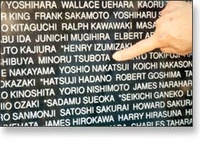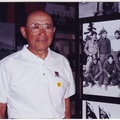“When I got married and had kids, I didn’t try to share with them too many Japanese things. And when they were born, I made sure none of them had Japanese first names.”
—May K. Sasaki
What we call ourselves says much about how we want the world to see us. Aspiring entertainers adopt stage names; militants drop the surnames of their oppressor ancestors; immigrants voluntarily or involuntarily end up newly dubbed in their new country. Usually outsiders don’t presume to rename someone else’s child. But time and again in the years preceding World War II, Nisei children had “American” names bestowed on them by Caucasian customers, playmates, and teachers who could not—or would not—grapple with the strange-sounding names given by their Issei parents.
Densho’s interviewees share stories of how they went from Hatsuji to Harry in neighborhood streets or classrooms. Other Nisei assumed European names to blend in, or to declare their American identity. With raised awareness during the redress era, still others reverted to the culturally rich names their parents brought from the old country. Each choice reveals where Japanese Americans fit into the mainstream.
Growing up in Seattle, Tatsuru Kimura became exasperated with teachers stumbling over the “tsu” sound in his name. By high school he decided to become Eugene rather than be called “you” by teachers. Upon entering a Seattle high school with many hakujin (Caucasians), Yukiko (Hirata) Miyake, recalls:
And so when I went to high school, why, high school there’s a lot more hakujin. I think I happened to be the, only two Japanese in my class for a long time, and this fellow’s name was Dick Setsuda and he was a graduating senior then, but I went in as a freshman, and he said—the teacher, I don’t know why the teacher called me Yukiko “Highrata,” and I told her my name is Yukiko Hirata. She never changed it. She was always, “Yukiko Highrata” and so Dick used to say that was a fun part whenever I stood up to say, corrected the teacher saying, “Yukiko Hirata is my name,” and the teacher would say Yukiko Highrata.
Ungainly results could come from the renaming game. James Suzuki, for example, laughs as he explains, “I was given the name ‘Turk,’ a nickname, because my Caucasian friends could not pronounce Teruyuki, so they shortened it and called me Turk. And similarly with my brother, he was Terumichi, and they called him ‘Term’.” Brother “Peter” had been Teruhisa at birth. The name changes erased a symbolic connection to the boys’ father, Teruhisa (teru = radiance).
Psychologist Stephen Fugita notes that the Issei gave their children both Japanese and European names, even within the same family, perhaps depending on their expectations of returning to Japan.1 The back-and-forth pattern was the case with Frank (Hideo) Yamasaki’s family. His sister Yaiko loved the name Dorothy; brother Harry wanted to be called Kazuo; there was Masao and then the youngest one, George. When asked why his parents flipped between English and Japanese, and why he changed his own name, Frank said:
I often wonder, too. Because most of the Isseis, at least my parents, were not educated and they come to a new country with very low exposure to other cultures. And someone must have told them, “Well, you’re in America, so you better have, name your son Harry.” But all his playmates, they all Japanese names. So he preferred to be called Kazuo and Kaz for short. Now with my brother Masao and myself, Hideo, it was in high school. All the while I was going to grammar school, whenever they came to my name, they would pronounce it Hidy-ho, Hedy-o. And I always, they always stalled when they came to my name, so I finally changed it to Frank and never had any problems...
It’s just that when it became so awkward for the teacher to always, you know, it did become somewhat embarrassing at times. Whenever it came to my name I used to know that Yamasaki followed “W,” and so when Jack White’s name is called, I know what’s going to happen next. There’s going to be a stall there and, “Hedy-ho, Yama... Yama...” You know, Yamasaki. Oh, my gosh.
Name changes for the Nisei are intricately involved in their self-identify, reflective of their self-respect or self-suppression as a racial minority. Upon leaving Minidoka incarceration camp, third-grader May Sasaki deliberately stopped answering to her Japanese name, with the affectionate “chan” ending. In her child’s logic she believed if she changed to “May,” she could avoid further punishment for being Japanese. Years later, as an adult going through cultural awareness training, she realized the loss.
Well, it must have left something because up until the time I had gone into camp, everyone referred to me with my Japanese name, which was Kimiko. And so I was always Kimi-chan, Kimi-chan, and that was okay. But I began to sense that it was because I was Japanese that I was in this camp because I looked around and we’re all Japanese. And I think that’s when I came to this decision that whenever I get out of here, I’m not gonna be Japanese anymore. At that age, it doesn’t make any sense but that’s what I decided. I never said anything to anyone but I remember that near the end when we were ready to leave, when people would call me Kimi-chan, I would pretend not to hear them. And I could hear them muttering and everything but I wouldn’t hear them, and I figured, “That’s the way I’m going to do it. I’m not going to be Kimiko anymore. I’m going to be May because that is my name also.” And when I...I never used my name Kimiko after.
Yeah, this was when I was doing some training. And she had said, “I don’t know why you’re doing this when you don’t even use your Japanese name.” And I just started crying. And here I was an adult and you’d think... and then later I explained to her how I lost that name and then she... but I thought, “Gee, why am I crying about that?” It doesn’t seem like anything that would, that I should just get mad at her, but I couldn’t. Because I was ashamed that I gave up that name. Anyway, here we go.
Upon returning to Seattle after release from camp, May attempted to erase her Japanese identity even further:
So I remember coming back to Seattle, and starting school, and I do remember one incident where a young Caucasian boy came up to me. And I knew he was not friendly because he had this very, well, he had this face, a look about him—and he said to me, “What are you?” And I knew what he was looking for, but I said, “I’m Chinese.” And he looked straight at me and says, “No you’re not. You’re a Jap.” And I recall that so much, I was thinking, “How did he know?” ‘Cause I was using my name May, and Chinese and Japanese look the same. And that kind of still reinforced that there’s something dirty or something bad about being Japanese. So I didn’t realize how strong that was in me, but even when I got married and had kids, I didn’t try to share with them too many Japanese things. And when they were born, I made sure none of them had Japanese first names.
LH: It was a conscious decision?
MS: It was. I remember my parents asking me why don’t I give them Japanese first names, and I said, “No, that’ll only hurt them, so we’ll just give them American names.”
Virtually all Nisei gave their children Western or “all-American” first names. A telling shift in Sansei middle names took place around the incarceration. Prior to and during the detention, 20% of Sansei were given European middle names. During the resettlement years, 70% of Sansei received European middle names. In the 1960s, there was a swing back to Japanese middle names at 60%. Scholars surmise that the shift indicated the Nisei generation’s desire to leave their foreign roots behind, while ethnic pride began to take hold during the civil rights era.2
Some Nisei who became involved in the civil rights and redress movement experienced a conflicted or dual identity, which was expressed in their names. Former detainee Tsuguo “Ike” Ikeda of Seattle was an active youth volunteer in church, and went on to lead a nonprofit devoted to social justice and racial equity. Ike explains his evolution from the quiet acceptance of his culturally Japanese upbringing to an American-style assertiveness:
And once I had this unique opportunity of being involved in a broader society, broader systems, educational system or whatever—you name it, these chances, opportunities were made to me. So then I began to have a two-faced thing about myself. In the Japanese Methodist Church, I was Tsuguo Ikeda, and in the broader society, I was Ike Ikeda. So it was a real fight internally, trying to be Japanese American, but at the same time, be more American, too, for a change, rather than primarily Japanese… It’s unusual how labeling changes your behavior, but that’s what I did.
As the painful years of detention receded, Aya Medrud, a Quaker activist in Boulder, Colorado, decided to return to her Japanese name, which suits this compassionate pacifist well:
Well, as you know, Mariagnes is, as I said earlier, is an Irish Roman Catholic name. I was named after the mother of a Catholic priest who baptized me. And one day, three or four years ago, I was writing my name on something and I thought, “I’m not really Mariagnes, I’m really Aya.” Mariagnes is a Roman Catholic name, which I have not been a practicing Roman Catholic for forty-two years, and Aya is my real name, and it’s a name that my grandparents and my parents gave me, and it means “love and affection.” And I thought, “Well, that seems to me, be me more than anything else.” So that’s when I told friends that I was gonna use the name Aya, and that my friends can use, keep calling me Mariagnes. But it’s really for myself that I’m doing it, so, “Don’t feel bad if you don’t remember.”
Notes:
1. Stephen S. Fugita and Marilyn Fernandez, Altered Lives, Enduring Community: Japanese Americans Remember Their World War II Incarceration (Seattle: University of Washington Press: 2004), p. 152.
2. Ibid., p. 153.
* This article was originally published on Denshō: The Japanese American Legacy Project.
© 2009 Densho












